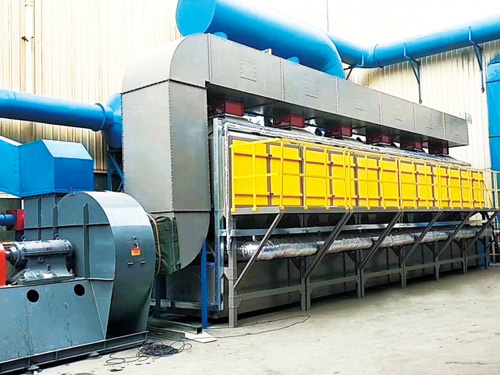Catalytic Combustion EquipmentIt Mainly Consists Of Activated Carbon Adsorption Box, Flame Arrester, Heat Exchanger, Catalytic Reaction Bed, And Fan. Compared With Direct Combustion, Catalytic Combustion Has A Lower Temperature And Cleaner Combustion.
Catalytic Combustion Equipment Is A Catalyst With Precious Metals And Metal Oxides On Its Surface. Under The Action Of Platinum And Palladium Catalysts, Pollutants In The Exhaust Gas Can Be Oxidized Into Carbon Dioxide And Water At Lower Temperatures. The Addition Of Catalyst Does Not Change The Original Chemical Equilibrium, Only The Rate Of Chemical Reaction, And The Properties Of The Catalyst Itself Do Not Change Before And After The Reaction.
In The Process Of Catalytic Purification Of Exhaust Gas, The Exhaust Gas Is Sent Through A Pipeline By A Fan To A Heat Exchanger, Which Heats The Exhaust Gas To The Starting Temperature Required For Catalytic Combustion. The Preheated Exhaust Gas Is Burned Through The Catalyst Layer. Due To The Action Of The Catalyst, The Initial Temperature Of Exhaust Gas Combustion In Catalytic Combustion Method Is About 250-300 Degrees Celsius, Which Is Lower Than The Combustion Temperature Of 650-800 Degrees Celsius In Direct Combustion Method. The High-temperature Gas Enters The Heat Exchanger Again, Is Cooled By Heat Exchange, And Finally Discharged Into The Atmosphere At A Lower Temperature Through The Fan.
Catalytic Combustion Equipment Refers To Devices Or Devices That Burn Under The Action Of A Catalyst. The Combination Of Catalytic Combustion Equipment And Condensation Technology Is Reflected In The Following Three Aspects:
1. The Exhaust Gas Generated At The Feed Inlet And The Outlet Of The Extruder Will Be Collected, And The Water Vapor Will Enter The Condensation Treatment Stage. During The Condensation Process, Condensed Water Will Be Generated, And The Condensed Water Will Be Collected And Processed By A Method.
2. Entering The Second Stage Of Condensation Treatment, Which Further Condenses On The Basis Of The Upper Stage Condensation To Improve The Effectiveness Of Condensation Treatment, Cyclohexane Is Produced During This Treatment Process. Cycloethane Can Be Collected And Reused As A Chemical Raw Material. At This Point, The Exhaust Gases From The First Two Stages Have Been Fully Condensed And Defogged. The Exhaust Gases Generated During The Process Of Drying Particles With Hot Air During The Transportation Of Solids By Wind Will Be Collected For Centralized Defogging Treatment. In The Defogging Process, Filling Oil Used In Rubber Production Is Generated, Which Can Be Collected And Reused Here, And All Exhaust Gases Have Been Fully Collected.
3. The Collected Exhaust Gas Will Be Heated Through A Steam Heat Exchanger To Increase The Efficiency Of Catalytic Oxidation Treatment. After The Catalytic Oxidation Of The Hot Exhaust Gas, The Gas Needs To Undergo A Cycle To Reduce The Heat Carried By The Heated Gas And Transfer It To The Untreated Exhaust Gas. This Process Can Reduce Energy Consumption And Save Thermal Energy Costs. After Multiple Catalytic Oxidation Reactions With Oxidants Such As Oxygen In The Air Under Normal Pressure Using Metal Catalysts, The Exhaust Gas Can Meet The Emission Standards Of Chemical Enterprises And Be Discharged Into The Atmosphere. It Can Also Be Sent To A Hot Air Drying System For Dry Treatment Using The Heat Carried By It. This Treatment Method Can Reduce Production Costs.




